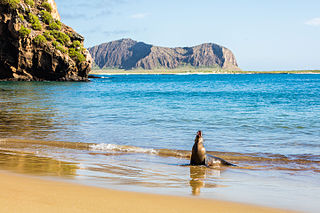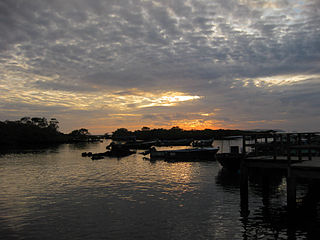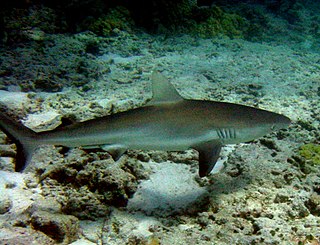
The Galápagos Islands are an archipelago of volcanic islands. They are distributed on each side of the equator in the Pacific Ocean, surrounding the centre of the Western Hemisphere, and are part of the Republic of Ecuador. Located 906 km (563 mi) west of continental Ecuador, the islands are known for their large number of endemic species that were studied by Charles Darwin during the second voyage of HMS Beagle. His observations and collections contributed to the inception of Darwin's theory of evolution by means of natural selection.

The Pinta Island tortoise, also known as the Pinta giant tortoise, Abingdon Island tortoise, or Abingdon Island giant tortoise, was a subspecies of Galápagos tortoise native to Ecuador's Pinta Island.

The Galápagos fur seal is one of eight seals in the genus Arctocephalus and one of nine seals in the subfamily Arctocephalinae. It is the smallest of all of the eared seals. They are endemic to the Galápagos Islands in the eastern Pacific. The total estimated population as of 1970 was said to be about 30,000, although the population has been said to be on the decline since the 1980s due to environmental factors such as pollution, disease, invasive species, and their limited territory. Due to the population having been historically vulnerable to hunting, the Galápagos fur seal has been protected by the Ecuadorian government since 1934

San Cristóbal Canton is a canton of Ecuador in the Galápagos Islands archipelago and one of the oldest in this insular geological formation. It consists of Española, Floreana, Genovesa, San Cristóbal, and Santa Fe Islands.

Santa Cruz is a canton in the Ecuadorian province of the Galápagos. Its area covers the islands of Baltra, Bartolomé, Marchena, North Seymour, Pinta, Pinzón, Rábida, Santa Cruz, and Santiago. As of the 2006 Galápagos census, it has a population of 11,262.

Isabela Canton is a canton of Galápagos Province, Ecuador, consisting of the islands of Isabela Island, Darwin, Fernandina, Wolf, and some minor islets. Isabela is the largest island in the Galápagos, and well known for its beaches, bays and coastal lagoons with a wide variety of plants and birds. The capital of the canton is Puerto Villamil.

The Galapagos shark is a species of requiem shark, in the family Carcharhinidae, found worldwide. It favors clear reef environments around oceanic islands, where it is often the most abundant shark species. A large species that often reaches 3.0 m (9.8 ft), the Galapagos reef shark has a typical fusiform "reef shark" shape and is very difficult to distinguish from the dusky shark and the grey reef shark. An identifying character of this species is its tall first dorsal fin, which has a slightly rounded tip and originates over the rear tips of the pectoral fins.

The Galápagos tortoise or Galápagos giant tortoise is a species of very large tortoise in the genus Chelonoidis. It comprises 15 subspecies. It is the largest living species of tortoise, with some modern Galápagos tortoises weighing up to 417 kg (919 lb). With lifespans in the wild of over 100 years, it is one of the longest-lived vertebrates. Captive Galapagos tortoises can live up to 177 years. For example, a captive individual, Harriet, lived for at least 175 years. Spanish explorers, who discovered the islands in the 16th century, named them after the Spanish galápago, meaning "tortoise".
Nesoryzomys fernandinae, also known as the Fernandina nesoryzomys, Fernandina rice rat, or Fernandina Galápagos mouse, is a species of rodent in the genus Nesoryzomys of family Cricetidae. It is found only on Fernandina in the Galápagos Islands, which it shares with N. indefessus narboroughi. Its natural habitat is subtropical or tropical dry shrubland. The conservation status of this endemic species continues to be investigated.
Nesoryzomys swarthi, also known as the Santiago nesoryzomys or Santiago Galápagos mouse, is a species of rodent in the genus Nesoryzomys of family Cricetidae. It is found only on Santiago in the Galápagos Islands. Its natural habitat is subtropical or tropical dry shrubland.

The Galápagos sea lion is a species of sea lion that lives and breeds on the Galápagos Islands and, in smaller numbers, on Isla de la Plata (Ecuador). Being fairly social, they are often spotted sun-bathing on sandy shores or rock groups, or gliding through the surf. They are the smallest sea lion species.
Ecuador Time (ECT), as named by the IANA time zone database, is the time observed in mainland Ecuador since 1931. Ecuador Time is at UTC-05:00 and has no daylight saving, except for a brief period in the 1990s during the government of president Sixto Durán Ballén. This means Ecuador without Galápagos Province, which observed Ecuador Time until 1986, when it switched to Galápagos Time (GALT), at UTC-06:00.

The Galápagos penguin is a penguin endemic to the Galápagos Islands, Ecuador. It is the only penguin found north of the equator. Most inhabit Fernandina Island and the west coast of Isabela Island. The cool waters of the Humboldt and Cromwell Currents allow it to survive despite the tropical latitude. The Galápagos penguin is one of the banded penguins, the other species of which live mostly on the coasts of Africa and mainland South America. It is one of the smallest species of penguin in the world. Because of their warm environment, Galápagos penguins have developed techniques to stay cool. The feathers on their back, flippers, and head are black, and they have a white belly and a stripe looping from their eyes down to their neck and chin. Each penguin keeps only one mate, and breeds year-round. Their nests are typically in caves and crevices as protection against predators and the harsh environment. The Galápagos penguin has a lifespan of about 15 to 20 years, but due to predation, life expectancy in the wild could be significantly reduced.

The North Galapagos Microplate is a small tectonic plate off the west coast of South America north of the Galapagos Islands. It is rotating counterclockwise between three much larger crustal plates around it, the Nazca, Cocos and Pacific Plates. To its south, another small microplate, the Galapagos Microplate is likewise rotating, but clockwise. Both microplates "mesh" along the interface between them.

The western Santa Cruz tortoise is a subspecies of Galápagos tortoise endemic to Santa Cruz Island in the Galápagos. They are found only on the southwestern slopes of the island, with an estimated range of 141 sq. kilometers. There are approximately 3400 individuals in the wild, and have seen rising numbers in population, despite being critically endangered. MtDNA evidence shows that there are actually three genetically distinct populations on Santa Cruz Island. They are characterised by a black, oval carapace that is domed, higher in the centre than in the front, and broad anteriorly. Their life expectancy is 175 years.

The Hood Island giant tortoise is a subspecies of Galápagos tortoise endemic to Española Island in the Galápagos.
Chelonoidis niger vicina, commonly known as the Cerro Azul giant tortoise, Iguana Cove tortoise or the Isabela Island giant tortoise, is a subspecies of Galápagos tortoise endemic to Isabela Island in the Galápagos.

Chelonoidis niger duncanensis, commonly known as the Pinzón Island giant tortoise, is a subspecies of Galápagos tortoise endemic to Pinzón Island in the Galápagos.

Chelonoidis niger chathamensis, commonly known as the Chatham Island giant tortoise or the San Cristóbal giant tortoise, is a subspecies of Galápagos tortoise endemic to San Cristóbal Island in the Galápagos.

The Santa Fe Island tortoise, also known as the Santa Fe tortoise or Santa Fe giant tortoise, is an undescribed extinct taxon of Galápagos tortoise endemic to Santa Fe Island in the Galápagos archipelago in the equatorial eastern Pacific Ocean. Evidence for the historic existence of the tortoise comes from 19th century anecdotes of whalers and settlers removing tortoises from the island, as well as the discovery of tortoise bones there by the 1905–1906 California Academy of Sciences expedition, with genetic examination of the bones indicating that they belonged to a unique taxon most closely related to Chelonoidis niger hoodensis, the Hood Island giant tortoise from Española Island.
















